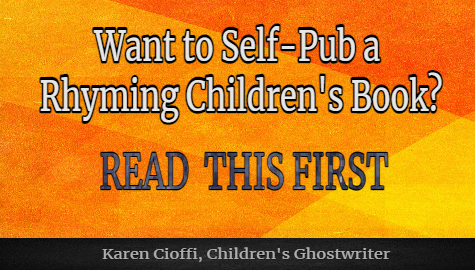As a ghostwriter I deal with a lot of new authors. One scenario I come across now and then is when someone sends me a story with rhyme.
When this happens, the story is lacking and the rhyme is unprofessional; it’s my job to guide these authors on the path of ‘doing it right.’
I recently received two such manuscripts. One had rhyme here and there throughout the story. The other rhymed every other line.
Unfortunately, some of the rhyming words were forced. This happens when the author ‘forces’ two words to rhyme. To accomplish this, the sentences are put together awkwardly (unnaturally), or one of the rhyming words is used unnaturally to make it rhyme.
Two examples of awkward rhyme:
Whenever I go to the park,
I run around and sing like a lark.
The forced rhyme below is from The Turtles’ “Happy Together” (1967):
“So happy together. And how is the weather?”
Notice the unnatural way these sentences sound. They don’t make sense. It’s easy to see they’re put together simply to rhyme the last two words. This unnatural rhyming causes the reader to pause, and pausing is never a good thing, especially in children’s books.
If a reader has to pause to get a grasp on what’s going on in a children’s book, it will cause confusion.
When a child gets the rhyme hook (gets into the rhyme), she will anticipate the rhythm and pattern throughout the story. The first verse or section the rhyme/pattern is missing, you will cause a PAUSE. And, if the rhyme is awkwardly placed here and there, it will also confuse the child. This pause or confusion will cause you to lose the story’s flow, focus, and the message you’re trying to convey.
You never want to cause a pause or confusion in a story, especially a children’s story.
But if you REALLY want to rhyme…
Below is a slightly more natural way to do this:
“Now it’s time to close your eyes, my dear. (8 syllables)
Beside you lies your favorite bear.” (8 syllables if you say favorite as fav-rite)
(From “Day’s End Lullaby.”)
Keep in mind that even this verse has its problems. One of those problems is ‘favorite’ is used with two syllables: fav rit. Technically, ‘favorite’ has three syllables: fav or ite.
So, you can see that while getting two words to rhyme isn’t that difficult, there’s lots more involved in rhyming ‘right.’
The bare-bottom elements of children’s rhyme:
• Each word and sentence need to be relevant to the story and move the story forward.
• There needs to be a continuing rhythm or beat to the sentences; this has to do with each word’s stressed and unstressed syllables.
• There needs to be a pattern throughout the story.
• It should be written without forcing words or using unnatural sounding sentences or meanings.
• It should all be wrapped up in a great story. You’ll need to know the elements of story writing for this one.
Summing it Up
Taking all this into account, if you’re thinking of writing a rhyming children’s book, read lots and lots of traditionally published rhyming books. And read those from the major publishers. Analyze how they’re written. Break them down.
You might even take an offline or online course on rhyming for children.
You can also check out Dori Chaconas’ website. She has an example of a syllable template you can use. Find it at: Icing the Cake (it’s at the bottom of the page).
If you’re still not sure you’re getting it right, find an editor who is skilled in rhyme.
Rhyming can be fun, and kids LOVE it, but please take care to do it right.
Sources:
http://www.billboard.com/articles/columns/pop-shop/6214232/20-most-forced-rhymes-music-ariana-grande-break-free
http://examples.yourdictionary.com/examples-of-rhyme.html
MORE ON WRITING FOR CHILDREN
The Book Summary – Five Must-Know Components
Finding Age Appropriate Words When Writing For Children
Ingredients for a Perfect Picture Book

I’m a working children’s ghostwriter, rewriter, editor, and coach. I can help turn your story into a book you’ll be proud to be the author of, one that’s publishable and marketable.
OTHER HELP I OFFER:
HOW TO WRITE A CHILDREN'S FICTION BOOK
A DIY book to help you write your own children’s book.
PICTURE BOOK, CHAPTER BOOK, MIDDLE GRADE COACHING
Four to twelve-week coaching programs.
WRITERS ON THE MOVE SELF-PUBLISHING SERVICE
Self-publishing help for children’s authors.
You can contact me at: kcioffiventrice@gmail.com. Or give me a call at 347—834—6700. (Please leave a message- I’ll get back to you as soon as I can.)


I have written many rhymes and kids short stories. Never had them published or attempted to. So this will be my very first time, I would appreciate some advice and what would the costs be and so on….
Hi, Jill. The very first step is to be sure your story is properly edited and in accordance with standard guidelines. There are a lot of factors that go into cost: the type of book, if it’s publishing-ready, if illustrations are needed, what service you use to format/design, and so on. This article has some information:
Traditional Publishing and Self-Publishing – The Differences
https://karencioffiwritingforchildren.com/2017/10/08/traditional-publishing-self-publishing-differences/